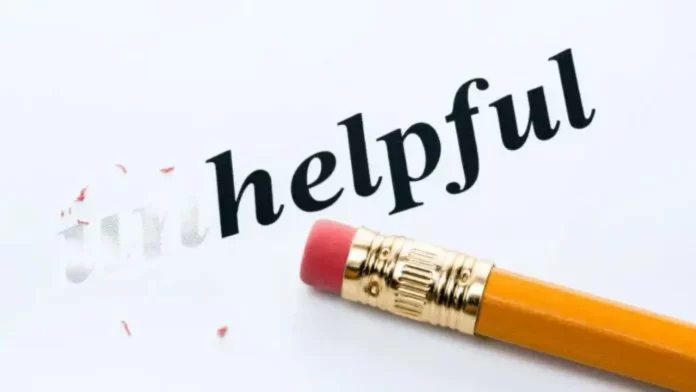Negative Feedback? How to strip out the helpful from the unhelpful
Some people take honesty way too far! They pride themselves on saying it how it is and BOOM, you’re knocked for six. They have a convenient excuse for their bluntness, of course:
“I’m just being honest – I call a spade a spade”.
On the one hand, negative feedback is a key driver of effective performance and the best leaders seek it out (Harvard Business Review, May 31st, 2018), but on the other hand, negative feedback can be inaccurate and driven by other people’s hidden agendas, jealousy, and/or insecurity. I’ve never believed in the statement, ‘ignore your critics’ but in this fast-paced world:
- How do you separate the accurate from the inaccurate?
- How do you process painful feedback, so you’re developed, not destroyed by it?
When we’re hit for six by negative feedback with no sugar-coating or silver lining, there are 3 stages which most people go through … and a 4th stage which is optional.
1) DEFENSIVENESS – Our amygdala (almond shaped cluster of cells in our brain which constantly scans for threat) perceives the negative feedback as a threat and goes on the attack.
“I can’t believe it.”
“What’s his/her/their problem with me?”
“He/she/they always do(es) this.”
“Ignorant ****!”
2) DOOM AND DESPAIR – Self-doubt, beating yourself up and wishing you’d done it differently.
“If only I was good at …”
“Why can’t I ever get it right?”
“I’m useless at this.”
3) DEALING WITH IT – We start to ask ourselves sensible questions about the feedback.
“Is there anything I could improve on?”
“Is there anything useful in this feedback?”
“Can I trust the feedback?”
4) DEVELOPMENT (optional) – So long as we have the right support and tools, we can progress into the development stage, where we improve some aspects of our output and grow as a result of the feedback. Without the right support/tools, there is a danger we’ll slip back into stages 1-3 and get stuck in a vicious circle with no development.
- Some people take a deep breath, creating a pause in their thinking. That pause may encourage them to sleep on it or to take a much-needed step back, asking trusted advisers what they think before drawing conclusions.
- Some people access a rehearsed memory of a beautiful experience, such as swimming in a lake with the sun setting, in order to create a moment of calm before reflecting on what’s been said.
- Some people draw on personal affirmations to encourage perspective and remind themselves of their strengths before considering the negatives.
I start with two assumptions about how the world works. These assumptions are my foundation and, on solid foundations, I then utilise a powerful visual tool.
Assumption 1
I am not the right fit for every person/event/team/job.
No amount of self-improvement will change this. Sometimes, people won’t like you or your work because YOU’RE THE WRONG FIT. Even booker-prize winning books will have one-star reviews on Amazon, given by intelligent people, who heard about the book, bought it, read it … and thought it was rubbish!
You can’t please everyone, and sometimes you’ll be in situations where you’re the wrong fit for the situation, that’s just life. Once you take this on board, you’ll start to expect negative feedback from time to time, so it’s no longer a shock when it occurs.
Assumption 2
Perfection doesn’t exist: outstanding does, but it’s rarely created if working in isolation. Until something is properly tested in the wider world, ‘good’ is the best you’ll achieve.
Elevating ‘good’ to ‘outstanding’ requires testing, feedback, reflection, re-design … testing, feedback, reflection, re-design … testing etc … then eventually you arrive at ‘outstanding’. There’s no escaping this: any piece of work will only ever be ‘good’ until you roll it out, take on feedback and start to craft what you’ve created.
With healthy and powerful assumptions in place, it’s time for shredders and filing cabinets … one of my favourite visual tools!
Step 1) Ask yourself:
Do I put this feedback in my mental shredder or mental filing cabinet?
Where you choose to put it depends on whether you trust the intentions of the person giving the feedback.
a) If you don’t trust his/her/their intentions, then it’s not worth the paper it’s written on, and the negative feedback goes into your shredder = THE END!
b) If you do trust his/her/their intentions (or at least have no reason to distrust them) then move to step 2.
Step 2) Ask yourself:
Which drawer of my filing cabinet will I put the feedback in? Top or bottom?
The drawer you decide depends on the answer to the next questions.
a) Is this part of an emerging theme? (other people have previously communicated this same issue to me)
If so, it’s the top drawer, so it remains high on your priority list and when you’re ready, you can open the drawer, look at it and do something about it.
b) Is this isolated as feedback? (no one has previously said this to me)
If so, you may choose to store it, but currently, it’s not a high priority. If someone else were to repeat this feedback and an emerging theme is forming, you may choose to move it to your top drawer (priority). If it remains isolated, perhaps you were the wrong fit or simply had a bad day.
Some of the best feedback you ever receive will be tough to hear at first, so do have strategies in place to help you process it in a resourceful state, so that truly, you can strip out the helpful from the unhelpful





